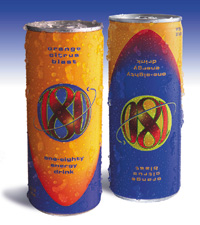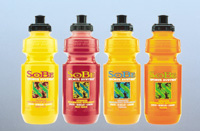
Although the c-store demographic hasn't changed much in recent years, manufacturers have altered their product mix to c-stores. Instead of just offering beef jerky, cigarettes and single-serve sizes of their grocery store lines, marketers are now developing products specifically for the c-store audience, and are using that audience to test the viability of new product ideas. According to U.S. Census Bureau data, there are currently more than 36 million people aged 21- to 30-years-old in the U.S. These young adults are a prime audience for food and beverage marketers.
On everyone's tongues at NACS was the term "alcoh-pops," the moniker for the new generation of drinks made with vodka and/or malt liquor, combined with fruit juices and/or lemonades, energy drinks and isotonic beverages, targeted at the newly legal and ready-to-spend Generation X.
For years Golden, Colo.-based Coors Brewing Co.'s Zima brand has been an industry joke, despite its longevity. In addition, the wine coolers of the 1980s are synonymous with low alcoholic content and women who aren't serious about drinking. But industry insiders said sweeter, less sophisticated mixed drinks appeal to today's 20-something drinkers.
Spirited Energy
At NACS, alternative soft drink maker Hansen Beverage Co. unveiled Hard E, what it calls the first New Age alcoholic beverage. The energy drink, a malt beverage with ginseng for energy, is also made with vodka and is being marketed with several taglines aimed at the 20-something crowd. A red devil-like character named Buzz is helping Hansen promote its "new kind of buzz" and the company also plays off the product name to encourage Gen Xers to "Party Hard E," a variant of the common college campus mantra.Ray LaRue, vice president of sales for Corona, Calif.-based Hansen, said research told them college students were already buying their energy drinks at c-stores, purchasing the vodka separately, and then mixing the two in a flask for use on the dance floor. The high they get from the alcohol combined with the buzz from the energy ingredients gives them an added lift, but at 5% alcohol content, similar to beer. In Detroit, some convenience stores are selling 10 cases per week, he said.

Wet Planet Beverages Global Beverage Co., the Rochester, N.Y.-based maker of the high-caffeine Jolt cola that is a hit with teens, noticed the same market opportunity. Last year, Wet Planet became the U.S. distributor of an Australian alcoholic spring water called DNA, flavored with seven fruits and spiked with vodka. Brian Creary, vice president of marketing, said the firm had expected DNA to do well only in metropolitan areas, but has seen it fly off the c-store shelves in rural areas in the four months it has been available domestically. In addition to the difficult to pinpoint fruit flavor, Creary said customers have noticed that the combination of alcohol and spring water lessens those morning-after hangovers. Furthermore, the DNA fingerprint logo glows under the black light used in many nightclubs, which Creary says is an added marketing bonus.
Those two firms are not alone in seeing the potential market in new alcoholic beverages for a generation that has grown up trying new things ranging from Internet dating to extreme adventure sports. According to research from Impact Data Bank, the 5% alcohol refreshers category was $680 million in 1998, including wine coolers, Zima and hard lemonades. The market is expected to grow 12.5% by 2005, with lemonade brews accounting for the majority of that growth.
Anheuser-Busch Inc., St. Louis, pushed its Doc Otis' hard lemonade, one of a handful of new lemonade and malt beverages at NACS. Another entry into that market was New York-based Seagram Beverage Co.'s Rick's Hard Lemonade.
John Bello, CEO of Norwalk, Conn.-based South Beach Beverage Co. also feels that today's teens and college students are a lucrative potential market (as much as $30 million for SoBe alone, the company hopes) as evidenced by the advertising tagline for SoBe's new energy drink: "Get It Up, Keep it Up." However, SoBe's new Adrenaline Rush, billed as a "maximum energy supplement" with taurine, guarana, D-Ribose and L-Carnitine in an 8.3-oz bottle, sized like competitor Red Bull, is alcohol-free. Bello knows consumers may combine it with alcohol, and, in fact, is planning promotions with Adrenaline nurses in nightclubs, but he would rather leave the alcohol mixing to others.
"The alcohol part of it could be a fad, like California coolers," he noted. "Where we really want to be is what made Mountain Dew popular." He said the taste of Adrenaline, combined with the specific properties of its ingredients to enhance both mental and physical energy, will help it catch on, with or without alcohol added. But the taurine and other nutrition facts won't be touted as good-for-you.
"Young people want to get a buzz and stay up all night. We make no pretense that this is a health drink. This is the party market," he said.
At NACS, Anheuser-Busch unveiled 180, its new orange blast citrus energy drink. The non-alcoholic 8.2-oz. beverage, packaged similarly to the first-in-market Red Bull, was test marketed in Las Vegas and Los Angeles last fall.
Good Sports
Alcoh-pops were just one of the product categories at NACS targeted to excite Gen Xers and tap into their desire to work hard, play hard and party hard. Sports drinks, already a $1.6 billion category, according to Schaumburg, Ill.-based ACNielsen U.S., is seeing continued growth, as marketers are making a name for them at golf courses, on college campuses and by sponsoring extreme sporting events that appeal to 20-something athletes, such as 24-hour multi-event "adventure" races.C-stores have seen some of their sports drink dominance dribble off to grocery stores, and new products that have added ingredients like herbs and vitamins are one way to lure the 20-something set back.
Lake Forest, Calif.-based Biosport Beverage Inc. had one of several new sports drinks with herbs like ginkgo, this one, called Biosport endorsed by A.C. Green (professional basketball player) at the show. Orlando, Fla.-based Arizona Beverage Co. licensed with tea-maker Celestial Seasonings to introduce a line of tea and juice "cocktails." Non-alcoholic, the beverages have the same herbal properties as the boxed teas, and use the same well-known drawings on the labels. Magic Energy has ginseng and guarana mixed with lemon, orange and mango juices as well as caffeine.
Cadbury Schweppes extended its Snapple functional beverage line with Gravity, which contains echinacea, beta-carotene and vitamin C--purported to boost the immune system. It also debuted Meteor, an energy booster with ginseng and gotu kola.
SoBe also entered the isotonic category with a line of sports drinks with glucosamine to help joints, D-Ribose for cardio enhancement and glutamine for muscle repair. The sports drink line is SoBe's first in a sports bottle with the easy-to-squirt and close cap, perfect for mid-workout sips. Quaker's Gatorade featured its new E.D.G.E. lid (which stands for Ergonomically Designed Gatorade Experience), a top on its 23.7-oz. bottles that can be opened and closed with the mouth, keeping hands free for gripping handlebars or rock climbing. Houston-based Robust Beverage Inc. thinks its new Fatigue Fighter sports drinks will attract the same audience.
Mike Rixman, southeast area sales manager, Virgin Drinks Co., is pumped about Virgin's new sodas, waters and energy drinks, already available in the U.K. and being rolled out domestically now. In focus groups, Rixman said the Virgin name and logo proved familiar to teens that shop at Virgin music stores and buy CDs from the Virgin label. The Wilton, Conn.-based company hopes that coolness will extend to its sodas and CurV, an energy drink in a proprietary curved bottle. RC Cola continued to promote its new Edge cola, spiked with taurine, ginseng and extra caffeine through WWF wrestling events.
Snack Attacks
Gen X likes more than drinks, of course, and manufacturers are ready to satisfy their appetites as well as their thirsts. M&M/Mars introduced Snickers Cruncher, a new variety of the Snickers' line, with rice, peanuts and caramel. According to Mars research, 90% of teens and 86% of young adults have eaten a Snickers bar in the last year.Also aimed at the testosterone side of the c-store, Charlotte, N.C.-based Lance introduced a line of 12 new $0.99 snacks--chips, popcorn, pretzel mix and cheese balls--under its Thunder name. Thunder products all have intense bold flavors, says Todd A. Phillips, senior director of marketing, a point-of-difference he hopes will help the line capture 20-something snackers and as a result, more shelf space from omnipresent competitor Frito-Lay. Flavors include a ridged potato chip in buffalo wings and blue cheese, a stormy salt and vinegar variety and a tornado taco corn chip.
"We think these highly-seasoned products will be a key entry for us," Phillips said. "They have macho appeal." PF